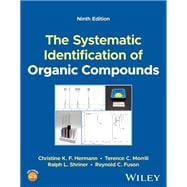A comprehensive introduction to the identification of unknown organic compounds
Identifying unknown compounds is one of the most important parts of the study of chemistry. From basic characteristics such as melting and/or boiling point to more complex data generated through cutting-edge techniques, the range of possible methods for identifying unknown organic compounds is substantial. The utility of a research reference which compiles known techniques and characteristics of possible compounds is clear.
The Systematic Identification of Organic Compounds provides such a reference, designed to teach a hands-on approach in the chemistry lab. It takes readers step-by-step through the process of identifying an unknown compound and elucidating its structure from infrared, nuclear magnetic resonance, and mass spectra in addition to solubility characteristics, melting point, boiling point, and classification tests. The result is an essential overview for advanced chemistry students looking to understand this exciting area of laboratory work.
Readers of the ninth edition of The Systematic Identification of Organic Compounds will also find:
- A detailed chapter on safety, personal protection equipment, chemical storage, safety data sheets, and other safety concerns
- New NMR, IR, and mass spectra with detailed explanations on interpretation
- Questions at the end of each chapter designed to facilitate and reinforce progression, keyed to a companion website for instructors
- Tables of known compounds including data relevant for identification
- Companion website with structural problems from experimental data for students to practice how to reason and solve
The Systematic Identification of Organic Compounds is a useful reference for advanced undergraduates and graduate students studying organic chemistry, organic spectroscopy, and related subjects.








